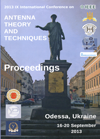Managing of microwave antennas of digital combined radio relay-troposcatter station
DOI:
https://doi.org/10.1109/ICATT.2013.6650841Keywords:
mobile station, microwave antenna, radio relay communication, troposcatter communication, algorithmAbstract
The usage of the communication systems in emergency situations is requiring the mobile stations of telecommunication. Therefore, the use of digital combined radio relay-troposcatter stations (DCRRTS) is fully justified. Proper selection of microwave antennas systems (MAS) largely determines the functional efficiency of mobile stations of telecommunication. In the elaboration of the DCRRTS one of the important issues is the selection of MAS that support two modes of operation: direct radio line (radio relay communication) and the out skyline (troposcatter communication). On the basis of the main advantages of reflector antennas - sufficient simplicity and reliability of a design, its transportability, the possibility of forming the required pattern, high gain, low noise temperature. This is the type of antennas is proposed to use in DCRRTS. For DCRRTS may be offered the next option to usage the following antennas: axisymmetric monoreflectible antenna for radio relay component of station and unaxisymmetric monoreflectible antenna for troposcatter component of station. Therefore there is a need to develop a control algorithm that automatically transfers station from one mode to another. This algorithm includes control of mechanical parts DCRRTS and its electrical characteristics.Published
2014-02-19
Issue
Section
Microwave technologies application

